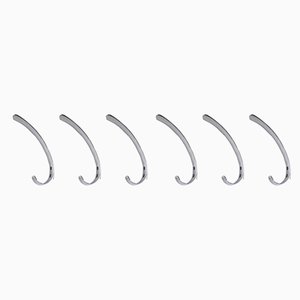
The Werkstätte Carl Auböck—dating back to four generations of Auböcks—was originally founded as a metal workshop in 1912 by Karl Henirch Auböck (1872-1925). It was well known for producing ‘Vienna Bronzes’—miniature bronze figurines and statuettes that were very popular in the early 20th century, as well as for its signature modernist accessories in the mid-century period.
Carl Auböck II (1900-1957) was an Austrian designer who apprenticed in bronze smithing and engraving at his father’s workshop in the early 1900s. He then moved on to fine art, studying painting under the Swiss expressionist painter-designer Johannes Itten at the Bauhaus school in Weimar, Germany (graduating in 1921). Carl married sculptor Mara Utschkunova soon after, and their son Carl Auböck III (1924-1993) was born a year later. The young father took on another role in 1926 when he inherited the family business. He applied the exuberant and glamorous Art Deco style to his bronze sculptures before taking a more modern approach, introducing brass into the Auböck catalogue. He continued to paint, developing an abstract style that was so well-received by critics and clients, that Carl Auböck II is remembered as much for his contribution to the fine arts as to the decorative arts.
His son Carl III, on the other hand, was fascinated by industrial design. In the 1950s, he studied architecture in the US where he met and befriended modernist design luminaries such as Charles and Ray Eames, Benjamin Thompson, George Nelson, Herbert Bayer, and Walter Gropius. Returning to Vienna, Carl III filled his father in on the movement that was revolutionizing the design industry. The pair worked well together, creating an array of slightly unconventional yet highly functional art objects, including paperweights, ashtrays, corkscrews, bottle stoppers, floor lamps, coat racks, and shoe horns. Venturing beyond the Vienna Bronzes that were hallmarks of his father’s style, Carl II painted and polishing the brass in his sculptures, achieving a contrast and character unlike other contemporary bronze works, including the Optimist/Pessimist and Man with Cane figurines (both 1950s).
Carl II passed away in 1957, leaving the family workshop to son Carl III, who succeeded in bringing the business to the international stage. He collaborated with luxury brands Hermès and Pierre Cardin, the fruits of which were subsequently sold in department stores and international retailers such as Tiffany & Co., Saks Fifth Avenue, and Bloomingdales in New York; Ginza Shiseido in Tokyo; Harrods in London; and Christofle in Paris. Today the company is run by Carl Auböck IV and his wife Justine. It is located in the original Viennese townhouse where it continues to produce both classic and contemporary design.

